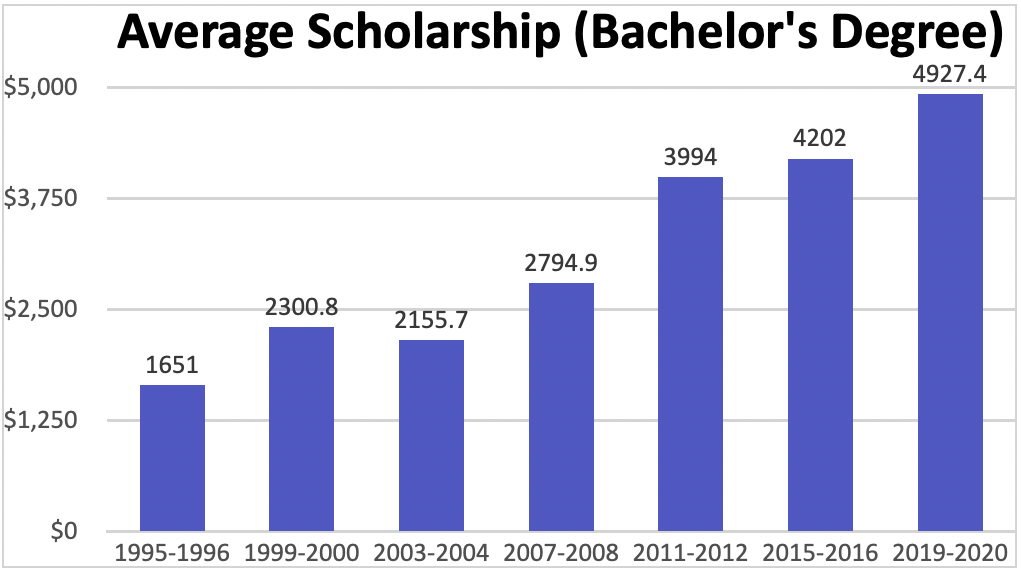
The number of private scholarships have increased significantly over the last four years, making it easier than ever to win a scholarship. The total number of undergraduate scholarships grew from 1.56 million in 2015-2016 to 1.88 million in 2019-2020, a 20% increase.
The total amount of private scholarships has also grown, from $6.1 billion in 2015-2016 to $8.3 billion in 2019-2020, with the average scholarship amount increasing from $3,852 to $4,338.
These statistics are based on an analysis of data from the National Postsecondary Student Aid Study (NPSAS), a quadrennial study about how students paid for college and graduate school. The 2019-2020 NPSAS was just released.
Growth In Scholarships For Students In Bachelor’s Degree Programs
Most undergraduate scholarships are awarded to students in Bachelor’s degree programs. They get three-quarters of the number of scholarships and 84% of the total scholarship dollars.
The number of scholarships for students in Bachelor’s degree programs increased from 1.15 million in 2015-2016 to 1.39 million in 2019-2020. The odds of winning a scholarship increased from 12.7% to 15.2%, so about 1 in 7 students in Bachelor’s degree programs win a private scholarship, up from 1 in 8. The average scholarship amount increased from $4,202 to $4,927, a 17% increase.
This chart shows the growth in the average scholarship amount over the last two decades.

Growth In Graduate Fellowships
The number and amount of graduate fellowships have also grown. Like scholarships, fellowships are a form of gift aid for graduate students.
The number of graduate fellowships increased from 189,500 in 2015-2016 to 237,526 in 2019-2020, a 25% increase. The odds of winning a fellowship increased from 5.3% to 6.5%. The total amount of fellowships increased from $1.28 billion to $1.87 billion, a 46% increase. The average fellowship amount increased from $6,752 to $7,890, a 17% increase.
Likelihood Of Winning A Full Ride
The odds of winning a full ride, that covers all college costs, is very low.
Only 1.4% of students in Bachelor’s degree programs have total gift aid covering the full cost of attendance. Gift aid includes grants and scholarships from all sources, not just private scholarships. College costs include tuition, fees, room, board, books, supplies, equipment, transportation and miscellaneous personal expenses.
A somewhat greater percentage of students in Bachelor’s degree programs, 3.1%, have total gift aid covering at least 90% of the cost of attendance.
Among students in Bachelor’s degree programs whose gift aid covers the full cost of attendance, about 41% of the gift aid comes from scholarships.
Only 0.5% of students in Bachelor’s degree programs receive at least $25,000 in private scholarships and 2.3% receive at least $10,000 in private scholarships. These amounts are for just one year.
There are very few scholarships that offer a top prize of $100,000 or more over four years. These include the Regeneron Science Talent Search (up to $250,000), Breakthrough Junior Challenge ($250,000), Jack Kent Cooke Foundation (up to $220,000), DOD STEM Scholarships (full tuition and fees, plus a stipend totaling $120,000), NSA Stokes Educational Scholarship Program (up to $120,000) and Dr. Pepper Tuition Giveaway ($100,000).
In addition, the QuestBridge National College Match Scholarship covers the full cost of attendance for selected low-income students at participating colleges, worth up to $200,000.
And don’t think that sports are your answer to a full ride scholarship either.
Characteristics of Scholarship Recipients
Scholarships enable recipients to buy up to a more expensive college. In 2019-2020, the average cost of attendance was $31,518 for scholarship recipients and $21,170 for non-recipients in Bachelor’s degree programs. Despite the high cost, the average net price was similar, $16,455 for scholarship recipients and $16,238 for non-recipients.
83% of scholarship recipients were enrolled at very or moderately selective colleges, compared with 75% of non-recipients. Students who enroll at very selective colleges are twice as likely to have won scholarships as compared with students at open admission colleges (17.7% vs. 8.5%).
63% of scholarship recipients had an above-average SAT or ACT test score, compared with 57% of non-recipients.
Bachelor’s degree students with a high school GPA of 3.5 or higher are more likely to win scholarships than students with a lower GPA (23.3% vs. 12.6%).
74% of scholarship recipients in Bachelor’s degree programs had at least a 3.5 high school GPA on a 4.0 scale, compared with 58% of non-recipients. This pattern persisted in college, with 52% of scholarship recipients having at least a 3.5 GPA in college, compared with 39% of non-recipients.
Students in Bachelor’s degree programs who were enrolled full-time are more likely to have won scholarships than students who were enrolled part-time (18.2% vs. 6.9%). 91.6% of scholarship recipients are enrolled full-time, compared with 79.0% of non-recipients.
Students who enroll in online programs are half as likely to have won scholarships (8.7% vs. 17.2%). 13.8% of scholarship recipients enrolled in online programs, compared with 25.8% of non-recipients.
Students who file the FAFSA are more likely to have won scholarships (17.3% vs. 9.1%). 84.6% of scholarship recipients filed the FAFSA, compared with 72.4% of non-recipients.
Students at private non-profit 4-year colleges are more likely to have won scholarships (18.9%) than students at public 4-year colleges (14.4%) and students at private for-profit 4-year colleges (6.2%). Only 2.8% of scholarship recipients enrolled at private for-profit 4-year colleges, compared with 7.5% of non-recipients. Scholarship recipients are more likely to enroll at private non-profit 4-year colleges (36.3% vs. 27.8%) and less likely to enroll at public 4-year colleges (61.0% vs. 64.7%).
Dependent students are more likely to have won scholarships than independent students (19.1% vs. 7.1%). 84.9% of scholarship recipients are dependent students compared with 64.5% of non-recipients. 15.1% of scholarship recipients are independent students compared with 35.5% of non-recipients.
Female students in Bachelor’s degree programs are more likely to win scholarships (16.2% vs. 14.0%), but the average scholarship amount is lower ($4,741 vs. $5,225).
White students in Bachelor’s degree programs are more likely to win scholarships (16.4%) than Black students (14.8%), Hispanic students (13.2%) and Asian students (11.4%). More than half of scholarship recipients are White (55.8%).
Bachelor’s degree students majoring in STEM are more likely to win scholarships than students majoring in a non-STEM field (16.6% vs. 14.6%).
Related: Who Gets Financial Aid And Graduates College Debt-Free
Final Thoughts
While college remains an expensive proposition, it’s getting easier to qualify for scholarships that can offset the cost of a degree. We can draw several conclusions from the statistics in this article, but the bottom line is that when it comes to Bachelor’s degree programs, a high GPA and college entrance exam scores increase your chances of winning a scholarship coming out of high school. Also, don’t base your scholarship strategy on winning a full ride, as the odds aren’t great.







